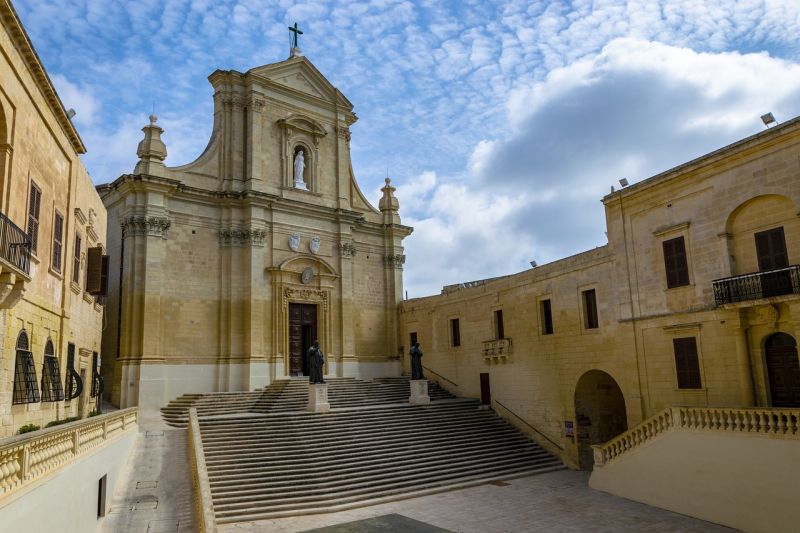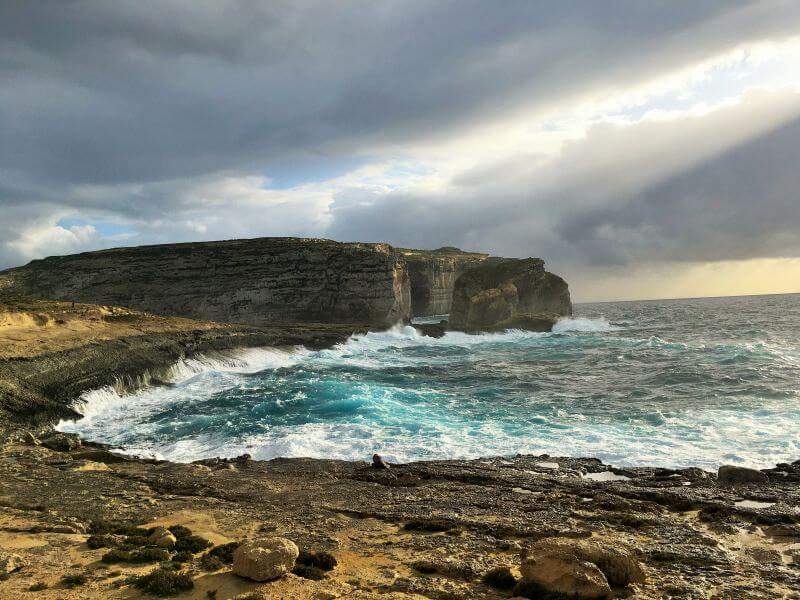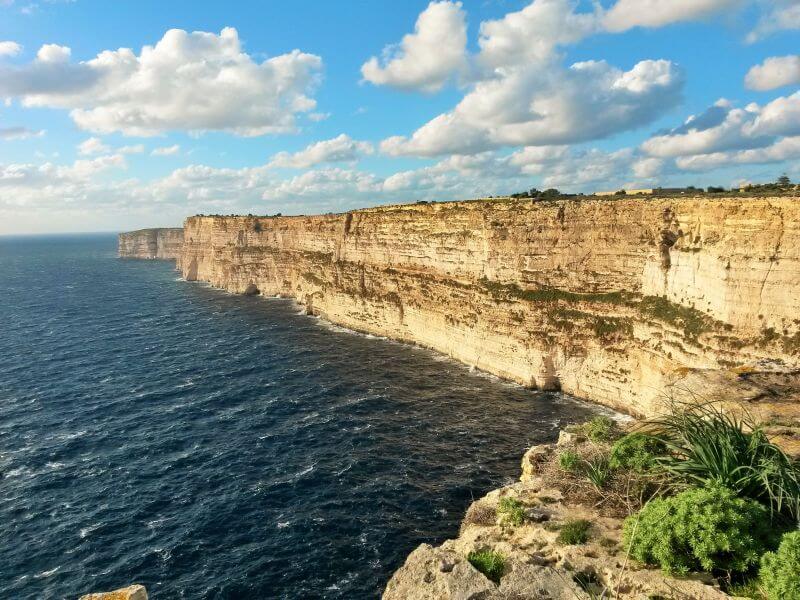Gozo is the second-largest and most densely populated island in the Maltese archipelago. It is inhabited by over 37,000 people and is about 5 km from Malta. You can get to Gozo by ferry, which costs a 4.65 euro return (you can only buy a ticket at the ticket office on the way back from Gozo). The journey takes approximately 25-30 minutes. We leave the port in Cirkewwa and reach the town of Mgarr. After exiting the ferry, there is a bus stop right outside the terminal building. What is worth seeing during our stay on this beautiful island?
1. Victoria (Rabat): the capital of Gozo
The Cittadella towers over the city, from its walls there is a unique view of Victoria and the surrounding area.

Within the walls of the Citadella, it is worth visiting, among others:
- Cathedral of the Assumption of the Blessed Virgin Mary – a baroque temple in which the relic (shoulder bone) of St. Ursula, the patron saint of the island. Inside, there is an illusionist fresco imitating a non-existent dome. In front of the entrance to the cathedral, there is a statue of John Paul II.

- Cathedral Museum – collection of chasubles, paintings, and liturgical equipment.
- Gozo Museum of Archeology – exhibit has the finds from the megalithic ruins of Ggantija, but also items from Roman and Phoenician times.
- Gran Castello Historic House – Folklore Museum – it is an interesting institution, created from several adjacent buildings. During the visit, we climb the stairs to several levels, we even go out to the internal terrace, all of which admiring, for example, a typical kitchen, bedroom, or an exhibition of agricultural, craft, and fishing tools.
- Old Prison – the greatest curiosity of this place is the original graffiti of prisoners carved into the limestone walls. Even Jean de la Valette, later Grand Master, was imprisoned here for 4 months (the capital of Malta, Valletta, was later named after him).
- Natural Science Museum – an old-style museum with exhibits of local flora and fauna. I recommend it to those interested in the subject.
Outside the walls of the Citadella, on St. George’s Square, is the baroque St. George’s Basilica. The bronze canopy above the altar is a reproduction of that of St. Peter in Rome.
2. Xagħra: Ġgantija Temples
The complex was entered on the UNESCO list as the first of all megalithic structures on the Maltese islands. According to researches, it was built between 3600 and 3200 BC. It consisted of two temples connected by a shared facade. The temples were used for a period of 1000 years, after which the culture of megalithic monuments disappeared in circumstances unknown to the present day. In the years 2500-1500 BC these objects were used as a cemetery. Ġgantija was built about a thousand years earlier than the Egyptian pyramids or Stonehenge. Its name, meaning the place of giants, comes from the beliefs of the inhabitants that the facilities were built by the giants living on the island. It is not surprising as some of the stone blocks weigh up to 50 tons!

There is one more interesting attraction in Xagħra. This is the Ta 'Kola Windmill, which has survived to the present day in its original condition. We can see the windmill’s mechanism as well as visit the rooms where the miller and his family lived.

3. Dwejra
Once upon a time, this bay was known primarily for Azure Window, a rock formation that gained its popularity through its appearance in the series Game of Thrones. Even though this beautiful rock arch collapsed in 2017, it is still worth coming here. It is a really beautiful piece of the coast, where we can admire, among others:
- Inland Sea – a small, sandy cove, almost completely separated from the sea by solid, high rock. Almost, because there is a small isthmus in it, thanks to which the sea waves can get into this inner basin, and tourists can go on a short boat trip on clear days.

- Fungus Rock – the name of this small island comes from the plant growing on it, from which the Knights Hospitaller produced their medicines. It was a rare cynomorium coccineum, mistakenly referred to as a mushroom. Interestingly, due to its value, it was protected by guards around the clock, and there were heavy penalties for theft.

4. The beaches and coast of Gozo
The island is famous for its beautiful coast and wonderful, crystal clear waters. However, there are not many typical beaches here. Still, a few of them certainly deserve our attention:
- Xlendi – a charming little village located in a narrow bay with a pebble beach. After relaxing in the sun, you can climb the short path to the cliff or walk to the watchtower and salt pans, which are nearby.
- Marsalforn – perhaps the most holiday destination on the island. There are several hotels built around the bay, restaurants, and a beach with coarse sand.
- Ramla – the most beautiful beach in Gozo, with red sand. Even though it is not in the city, you can easily get there by bus. Besides, it is known for the fact that on the slope by the beach there is Calypso Cave. According to tradition, this is the place where the nymph Calypso, who held Odysseus for 7 years on his way home, lived. Unfortunately, the cave collapsed some time ago, and although it is described, the entrance to it is blocked. There is, however, an observation deck overlooking the surrounding area.

- Ta’ Ċenċ Cliffs – although lower than the Dingli cliffs in Malta, which I wrote about in this article, are even more impressive. The area is wild (you should be very careful when exploring the area because the cliffs are not fenced in any way!) And the view is stunning. The panorama stretches over the neighboring Comino and Malta. They look especially picturesque just before sunset, illuminated by golden rays. This is one of the places that made the biggest impression on me on Gozo. They stretch along the sea for about 2 km to the Sanap Cliffs.

5. Gozo – places of worship
- Basilica of the Blessed Virgin of Ta 'Pinu – this important place of worship and pilgrimage is relatively rarely visited by tourists. It is located away from other attractions of the island. The voice of the Mother of God encouraging to pray the Hail Mary was heard by a local girl. The church was also visited by John Paul II during his trip to Malta.

- Rotunda of St. John the Baptist in Xewkija – is visible from many places on the island, especially on the route from the port of Mgarr to the capital of Victoria. It’s worth staying here for a while. The church is said to have the third-largest in the world, an unsupported dome. There is an observation deck at its top.
Please, check out also my article about the greatest attractions of Malta island!

